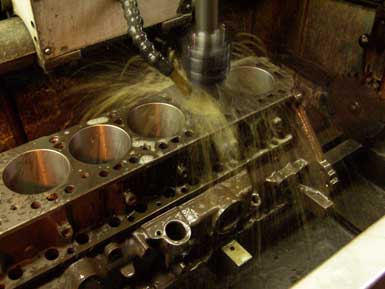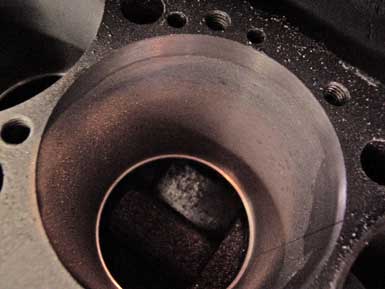Cylinder blocks

In a first step all threads are recut or repaired with coil inserts. Main cap bolt threads are also cleaned and recut before all cylinders are bored to the required oversize based on the standard diameter and added oversize.
Here we figure the required oversize for a 350 Chevrolet V8 small block engine:
Standard diameter 4,00 inches/101,60 millimeters.
According to the wear grade we measure a maximum cylinder diameter of 4,18 inches/102,57 millimeters. Since some cylinders show slightly vertical grooves we decide on a final cylinder oversize of +0,030 inches/+0,762 millimeters to which all cylinders are bored, leaving a few hundredths millimeters of material for the final honing process.
For this finishing process we figure the exact diameter of each piston previously assigned to a cylinder and add the required piston-to-wall clearance. In this final process the extremely important cross cut cylinder wall texture is applied to ensure proper piston ring lubrication.
If you look at the following table of common oversizes you will realize that there is no influence to the thermal performance of any engine as often suggested:
Cylinder oversize=0,010 inches/0,254 millimeters; material removal from cylinder wall=0,005 Inches/0,127 millimeters
Cylinder oversize=0,020 inches/0,508 millimeters; material removal from cylinder wall=0,010 Inches/0.254 millimeters
Cylinder oversize=0,030 Inches/0,762 millimeters, material removal from cylinder wall=0,015 Inches/0,381 millimeters
Cylinder oversize=0,040 Inches/1,016 millimeters, material removal from cylinder wall=0,020 Inches/0,508 millimeters
Cylinder oversize=0,060 Inches/1,52 millimeters, material removal from cylinder wall=0,030 Inches/0,762 millimeters
Figuring an average wall thickness of 8 millimeters you will realize that a material removal of even 0,762 millimeters will not influence the thermal performance of an engine.
However, there are a few exceptions like i.e. the 351 Ford Cleveland engine that should not be bored beyond 0.030 inches/0,762 millimeters due to an extremely thin and fragile cylinder wall.
Especially vintage engines have either been rebuilt in the past or have a significant wear grade so that there will be no choice other than boring the cylinders to the maximum available oversize of 0,060 inches/1,524 millimeters.
If a cylinder is broken or cracked all the way up to the head gasket surface the block is also determined non-rebuildable. The remaining cylinder wall areas will not provide enough strength for the press-fit required for sleeve installation. Water would leak from behind the sleeve all the way up and enter the combustion chamber area.
